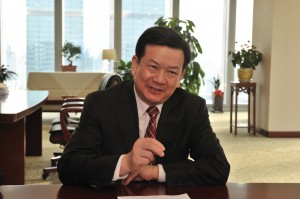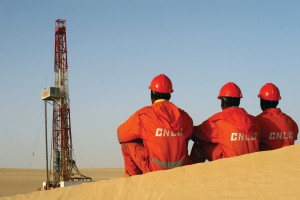Full steam ahead on shale gas, automation
For CNPC, wellbore stability, fluids are key challenges to China’s unconventionals development
By Mike Killalea, editor

Liao Yongyuan is vice president of China National Petroleum Corp (CNPC) and conference chairman for the 2012 IADC/SPE Asia Pacific Drilling Technology Conference & Exhibition, 9-11 July, Tianjin, China.
As vice president of CNPC, what do you see as the most critical challenges confronting your drilling operations today?
Technical engineering service is a very important component of CNPC as an integrated international energy corporation. CNPC is dedicated to building an integrated energy corporation, so we not only have a very important job within China conducting oil and gas exploration and production but also the very important job of providing technical services to our overseas operations.
Over the past few years, we have been facing quite a lot of challenges. First, in the past we were exploiting very shallow reservoirs with very few difficulties. Nowadays we are developing very poor resources in very deep reservoirs. Also, geological conditions are quite complex, which poses challenges to technical and engineering services. The average well depth for CNPC is increasing 100 meters per annum.
Second, we have a large number of engineering and technical service teams within China, and that leads to some difficulties in managing those teams. Again, we are also encountering some difficulties due to complex geological conditions.
Another area of endeavor is to increase both single well production and recovery rates, so that is very challenging. In addition, parts of China are piloting areas like tight gas and shale gas. Also, Chinese government authorities are paying more attention to safety and environmental protection and energy conservation, posing challenges in these areas, including emission reduction.
I would like to name a few examples. Ultra-deep wells in the Tarim Basin were drilled to about 8,000-meter total depth. Downhole temperatures encountered in the natural gas well we are drilling in the Daqing area have bottomhole temperatures well above 252°C. In Tarim, the steepness of the formation requires mud densities of some 2.6 g/cm3. So we are experiencing some challenges in terms of the mud density and the very complex geological conditions.
Another challenging area is toxic gas like H2S.
We have encountered virtually all challenges facing the global industry. This has put pressure on us to improve our management practices and our technologies.
I want to come back to the international aspect in a little bit. But first, it has been big news that CNPC and Shell have launched a joint venture and are working together to develop a highly automated well manufacturing system. We around the world are watching this closely. What does CNPC hope to achieve with this well manufacturing system that you’re developing with Shell?
The joint venture (JV) with Shell and CNPC is a partnership between two very strong companies. Shell is a very large international oil company while CNPC is an integrated energy corporation combining an oil company and a technical and engineering service.
CNPC’s advantages include equipment manufacturing and technological service. Further, we conduct wellbore operations, drilling and completion. Shell has extensive experience in gas development and in well-construction technologies under government commission. The combination of the two companies means that we will be able to efficiently develop coalbed methane (CBM), shale gas and tight gas.
Our goal is a highly automated well-manufacturing system. Shell’s experience with automated drilling technology will allow us together to develop a fully automated drilling system, as well as provide services in well completion.
Shell and CNPC have partnered in Australia. Together, we acquired Arrow Energy to develop CBM there.* In addition, Shell already has operations in China to develop shale resources.
This joint venture will help CNPC in three ways. First, it will improve CNPC’s operational capability. While we are making strides independently in this area, we still lag the majors.
Second, the JV will enhance CNPC’s equipment manufacturing as we develop this fully automated, high-efficiency rig and well-construction system. This is very new to us.
Third, we will improve our ability to explore and produce resources independently, that is, without a commissioned partner.
We believe that China is rich in resources. But again, in exploration development, we are still behind international major oil companies.

Where will CNPC apply the well-manufacturing system?
The technology will first be applied to joint ventures overseas together with Shell, specifically in the Arrow CBM project in Australia. Second, we will utilize the well-manufacturing system within China on joint Shell/CNPC blocks. Finally, as the technology develops, we may apply it to projects separately by Shell and CNPC or to international projects owned separately by the two companies.
CNPC drilled a shale gas well in Szechuan in 2011. Have you drilled any other such wells since the first one, and what challenges does CNPC face in developing that resource?
We have drilled several wells in Szechuan for shale gas. Some were quite successful, and in some we have encountered difficulties. We have drilled horizontal wells within 30 days and are seeing good results.
One of the key difficulties lies in correctly interpreting the physics of the reservoir. Therefore, we may have difficulty maintaining good wellbore stability.
The second area relates to the quality of the drilling fluid. This affects the drilling speed, of course, and poses difficulties for well completion. However, of the two problems, this is the easier for us to solve. We have dedicated research to this problem and are liaising within CNPC to tap additional resources.
I believe that progress is on the horizon. Despite these difficulties, we will not slow our pace in developing shale gas.
One of the newer technologies that has come on globally is rotary steerable systems. The high cost of rotary steerable systems have prevented it from being used extensively on land drilling, but now there are some simpler versions. Is CNPC beginning to use rotary steerable systems to speed directional drilling on any of its rigs?
We have applied Schlumberger’s rotary steerable systems in about 15 long horizontal wells. In 2011, our drilling plan called for about 1,000 horizontal wells, and that will increase to 1,500 horizontal wells in 2012. In addition, we plan to drill horizontally outside of China.
There is a high demand for rotary steerable systems, but the price is very high, which limits our ability to expand the use of these systems. As for simplified versions, they can satisfy operational needs and reduce prices. CNPC welcomes products featuring both low price and high quality.
Horizontal well technology plays a very important role in CNPC, because it can improve well production and increase E&P efficiency, and therefore, profit. If we can succeed in reducing costs, we will develop more horizontal wells in the future. Since rotary steerable systems account for a significant portion of horizontal-well costs, costs reductions here are extremely beneficial.
When we’ve talked about shales, you’ve referred to drilling speed issues and well stability issues. I’ve seen these myself just in deep wells in China. How is CNPC working to increase drilling speed?
In recent years, we have dedicated much effort to increasing drilling speed, efficiency and quality. Since 2005, we have successfully increased drilling speed in the Szechuan field.
CNPC’s overall drilling speed has increased 10% per annum over the past couple of years.
We are taking multiple approaches to improve drilling speed. First comes safety. As we work to improve speed, we want to ensure safety for equipment, personnel and the well. Second is management. We closely manage each step of the drilling process to ensure speed increases. Third, we are striving to apply advanced technologies developed by CNPC, as well as by our international peers, and to advance our practices to make best use of those technologies.
Fourth, we are building cooperation and synergies between our technical and engineering teams and those of international oil companies. This is to ensure that common goals exist. To build these synergies, we are reforming and restructuring our technical and engineering segment, beginning in 2007.
Our success is born out in some statistics. Currently, we are running 25 fewer rigs than in 2007. However, the number of wells and total footage have increased 29.8% and 45.5%, respectively, compared with 2007.
We have also worked hard to innovate technically. We will in the future release 10 technical results. Some of them will be very significant internationally and are already taking leading positions within China. We are using international benchmarks to judge the work of our own teams. In turn, this creates incentives for our teams to increase drilling speeds. We also offer prizes, like gold, silver and bronze medals, as further incentives.
I know that CNPC has worked hard to improve the capacity of its petroleum engineering technology services. What progress has CNPC made in that area?
First is that we have seen overall improvements in service level and in our competitiveness. We have also experienced efficiency increases for single rigs and single crews. Second, footage is increasing. In our Daqing drilling operations, for example, we drilled more than 9.8 million meters. This year, with just two drilling crews, we drilled about 110,000 meters, with average well depths of 2,500 meters. Further, we achieved these results over just nine months, because we do not drill during winter (in Daqing).
Internationally we have drilled 120,000 meters per annum. We could not have expected such results in the past.
We have also seen very significant progress in technology. We have increased our core competitiveness. In the past, we would rely on imports for hardware or facilities. But more recently, we have developed numerous advanced technologies within CNPC in the engineering and service side. Our engineering and technical service team have generated significant value for our customers. Thanks to these developments, CNPC now enjoys a good reputation not only in China but also among our international peers.

We’ve talked a lot about the technical side and discussed the challenges and progress that CNPC has made. Now I’d like to talk a little bit about our most important asset – our people, their competency and HSE. How has CNPC worked to increase the competency of its personnel on rigs?
We have put significant efforts in HSE system construction. We all know that the engineering and technical service industry is a very dangerous industry, so we are striving to train our people in HSE and in their skills.
There are three areas of effort here. The first step is to strengthen team training and to ensure they receive certificates before going to work. Each employee must be trained before going to work on the operation. And after training continuously over the past few years, we have observed a significant improvement in employee skills and HSE philosophy.
Over the past few years, we have accelerated our training efforts. We train our employees using multiple tools and methods, including simulation training. Also, each of our engineering and technical companies have their own training centers.
We are further summarizing lessons and experiences from material accidents from the past, as well as lessons from our international peers. We are looking for critical points to improve.
We have focused specifically on well control and mechanical injury. Our training has led to solid HSE results. In the past two years, we have had no material accidents, no fatalities, no major injuries and no environmental incidents.
We have learned from our international peers the value of the DuPont STOP program and have successfully combined DuPont STOP with CNPC practices. This has produced good results.
Frankly, in the past we considered the engineering and technical aspects of HSE as most important. That is no longer the case, due to our improvements. Still, we have a very large gap with our international peers.
That’s not something we are proud of, and we simply need to move forward pragmatically and steadily.
CNPC has, for some time, been moving to work internationally. What competitive advantages does CNPC have in petroleum engineering technology service internationally?
We began operating overseas more than 10 years ago. The target for this year is to build the “overseas Daqing oil field.”** That’s what we call it. The target is to reach total overseas oil and gas equivalent production of around 100 million tons per year and 50 million tons equivalent for CNPC’s share of production. That (latter amount) should be equivalent to the highest one-year production of Daqing in its peak time.
We can reach this target this year, thanks to CNPC’s international expansion. We have also experienced rapid development in the technological and engineering segment, even though we did not launch these services overseas until after we began international oil and gas exploration development.
We have advanced in three areas. First is our international scale. Currently, CNPC operates 280 rigs internationally in more than 40 countries with about 1,040 teams. These crews work in areas like logging, well testing and job prospecting. This represents 20,000 people, and the overseas revenues of the engineering segment will account for more than 30% of our total engineering segment. This increase in scale has occurred in just the past five to six years.
The second area we call orderly development. In the past, there would be many CNPC subsidiaries working in a single country, and they inevitably competed with one another. During 2008, we consolidated our overseas teams, and the results have been very satisfactory.
Third, we are learning from our international peers and trying to localize overseas employees. Currently, the Chinese-to-local employee ratio is three to seven, overall. For some products, only one in four employees is Chinese, and in a few, we are at 100% local employees.
Further, we have successfully trained our staff to function well internationally. This requires work in four areas. First is language, in order to communicate with local people easily. Second is project knowledge. Third is a detailed knowledge of the technology, and fourth is experience and knowledge of local laws and regulations.
CNPC has recognized the opportunities available internationally. The key is to have international teams available to quickly recognize these opportunities.
CNPC’s engineering and technical arms have gained international recognition. Like our operations in Iraq, our major achievements are accomplished by the CNPC engineering service. So here we are actually as good as our international peers. Our next step is to increase efforts in researching core technologies and special applications, where a gap still exists between us and our international peers.
* In March 2010, CNPC subsidiary PetroChina and Shell Energy Holdings Australia acquired Australia-based Arrow Energy.
**Daqing is China’s oldest and most prolific oilfield. Located in northeastern China, it is among the five largest fields in the world.
